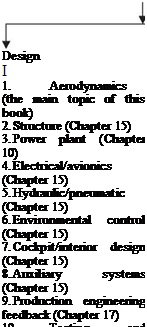Typical Design Process
The typical aircraft design process follows the classical systems approach pattern. The official definition of system, adopted by the International Council of Systems Engineering (INCOSE) [5] is: “A system is an interacting combination of elements, viewed in relation to function.” The design system has an input (i. e., a specification or requirement) that undergoes a process (i. e., phases of design) to obtain an output (i. e., certified design through substantiated aircraft performance), as shown in Figure 2.1.
As subsystems, the components of an aircraft are interdependent in a multidisciplinary environment, even if they have the ability to function on their own (e. g., wing-flap deployment on the ground is inert whereas in flight, it affects vehicle motion). Individual components such as the wings, nacelle, undercarriage, fuel
 |
system, and air-conditioning also can be viewed as subsystems. Components are supplied for structural and system testing in conformance with airworthiness requirements in practice. Close contact is maintained with the planning engineering department to ensure that production costs are minimized, the schedule is maintained, and build tolerances are consistent with design requirements.
Chart 2.1 suggests a generalized functional envelope of aircraft design architecture, which is in line with the Aircraft Transport Association (ATA) index [6] for commercial transport aircraft. Further descriptions of subsystems are provided in subsequent chapters.
Extensive wind-tunnel, structure, and systems testing is required early in the design cycle to ensure that safe flight tests result in airworthiness certification approval. The multidisciplinary systems approach to aircraft design is carried out within the context of IPPD. Four phases comprise the generic methodology (discussed in the next section) for a new aircraft to be conceived, designed, built, and certified.

 |
Civil aircraft projects usually proceed to preproduction aircraft that will be flight-tested and sold, whereas military aircraft projects proceed with technical demonstrations of prototypes before the go-ahead is given. The prototypes are typically scaled-down aircraft meant to substantiate cutting-edge technologies and are not sold for operational use.
Chart 2.1. Aircraft system













